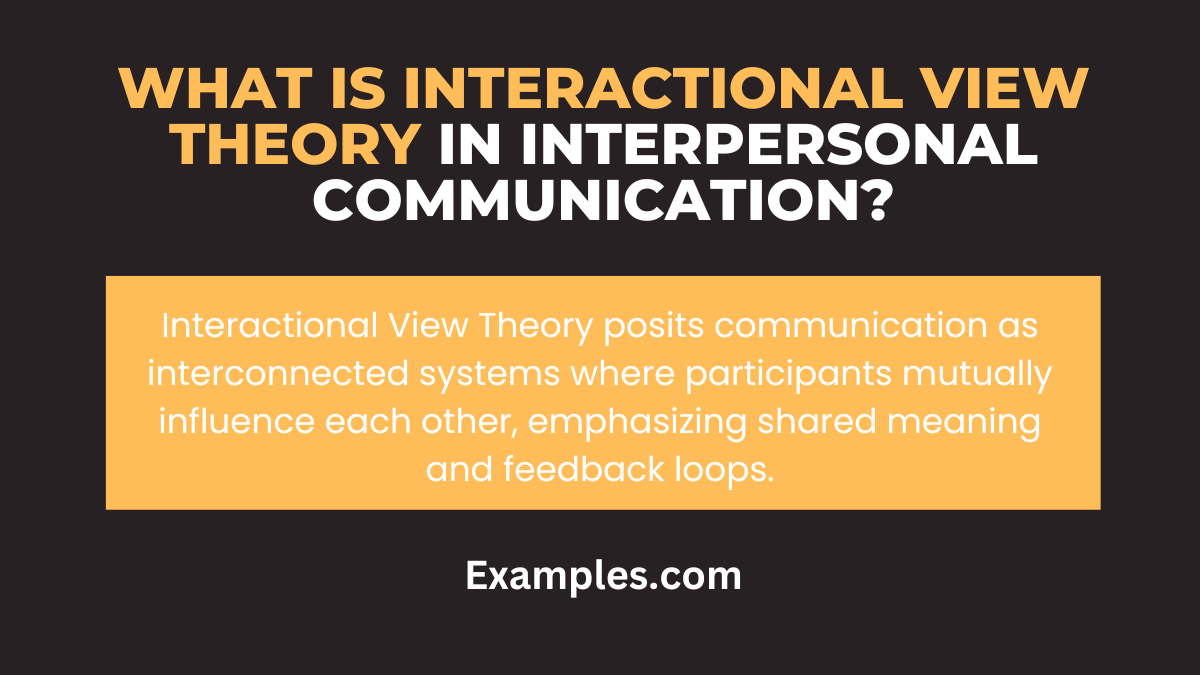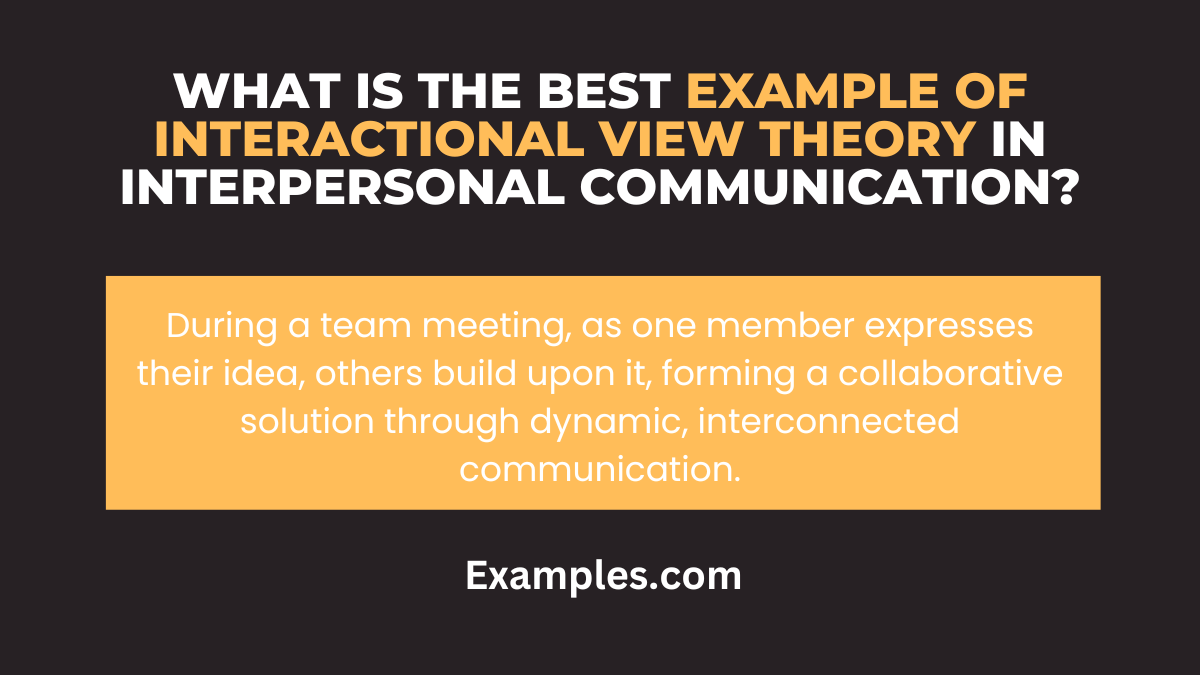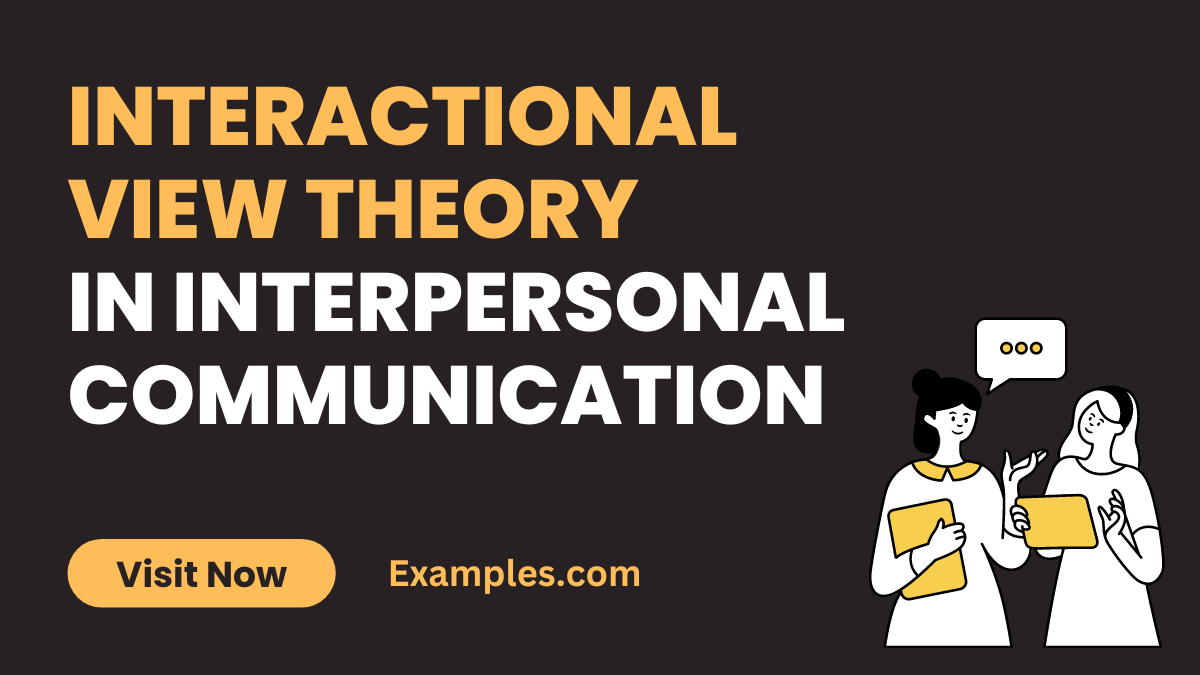19+ Interactional View Theory in Interpersonal Communication Examples
Delve into the fascinating world of Interactional View Theory in Interpersonal Communication! This comprehensive guide offers a rich exploration of how this theory shapes our daily interactions. From personal relationships to professional dynamics, understand the intricate web of communication patterns and behaviors. With practical examples, enhance your communication skills and navigate complex interpersonal landscapes with ease and clarity.
What is Interactional View Theory in Interpersonal Communication?

Interactional View Theory posits that in Interpersonal Communication, messages are not simply sent and received in isolation. Instead, they are part of a dynamic, ongoing process where each interaction influences and is influenced by past and future communications. This theory underscores the interconnected nature of human interactions, emphasizing the importance of context, relationships, and communication patterns in understanding how messages are constructed and interpreted.
History
Who Created: Paul Watzlawick
Date: 1960
The Interactional View Theory is a significant concept in the realm of Interpersonal Communication. Developed by Paul Watzlawick, this theory emphasizes the complex and multi-layered nature of human communication. It posits that every interaction is part of a system, where each member influences and is influenced by the others. The key aspect of this theory is that it views communication as a process that is more than just the sum of its parts.
What is the Best Example of Interactional View Theory in Interpersonal Communication?

A prime example of Interactional View Theory in Interpersonal Communication is a family dinner conversation. Here, each member’s communication style, history, and relationship with others influence how messages are conveyed and perceived. For instance, a joke made by one member may be interpreted differently based on past interactions, existing relationships, and the emotional context of the conversation. This demonstrates the theory’s emphasis on the interconnectedness of communication acts, where each message is part of a larger, complex system of interactions within the family.
20 Examples of Interactional View Theory in Interpersonal Communication

Exploring Interactional View Theory in interpersonal communication enriches our understanding of complex human interactions. This theory, integral in theories of interpersonal communication, provides a framework for analyzing how individuals shape and are shaped by their communication patterns. Understanding this theory is crucial in various contexts, from personal relationships to professional environments.
- Family Dynamics: A parent consistently interrupting a child may lead to the child feeling undervalued.
How to communicate: “I noticed I often interrupt you. Let’s work on listening more to each other.” - Workplace Feedback: Constructive criticism is given, considering the employee’s feelings, fostering a positive work environment.
How to communicate: “I appreciate your hard work. Here’s how we can further improve.” - Friendship Bonds: Friends sharing personal stories reciprocally, strengthening their bond.
How to communicate: “Your story reminds me of a similar experience I had. Let me share.” - Romantic Relationships: Partners discussing issues calmly, avoiding negative patterns like blaming.
How to communicate: “Let’s talk about this without pointing fingers. What’s your perspective?” - Teacher-Student Interaction: A teacher’s encouragement can boost a student’s confidence and participation.
How to communicate: “You’ve made great progress. Keep it up!” - Peer-to-Peer Support: Colleagues offering help to each other enhances teamwork.
How to communicate: “I see you’re swamped. How can I assist?” - Customer Service: Positive and empathetic communication increases customer satisfaction.
How to communicate: “I understand your concern. Let me resolve that for you.” - Online Communication: Respectful and clear messaging maintains positive digital interactions.
How to communicate: “I appreciate your point of view. Here’s another perspective.” - Conflict Resolution: Acknowledging each other’s viewpoints to find a middle ground.
How to communicate: “I see your point. Let’s find a solution that works for both of us.” - Social Networking: Sharing and reacting to content builds a sense of community.
How to communicate: “I love what you shared. It resonates with me because…” - Cultural Exchange: Understanding and respecting cultural differences in communication.
How to communicate: “Tell me more about your traditions. I’m interested to learn.” - Emotional Support: Validating someone’s feelings in times of distress.
How to communicate: “I’m here for you. Your feelings are completely valid.” - Group Discussions: Each member’s contribution leading to comprehensive problem-solving.
How to communicate: “Your idea is interesting. Let’s explore it further.” - Feedback in Teams: Balanced feedback promotes growth and team cohesion.
How to communicate: “Your input was crucial, and here’s how we can improve further.” - Mentor-Mentee Interaction: Mentors guiding while respecting mentees’ individual paths.
How to communicate: “What are your goals, and how can I support you?” - Parent-Teacher Meetings: Collaborative discussions about a child’s progress.
How to communicate: “Let’s work together to support your child’s learning journey.” - Healthcare Communication: Doctors explaining diagnoses clearly, considering patient emotions.
How to communicate: “Let’s discuss your treatment options and any concerns you have.” - Public Speaking: Speakers adapting their message to engage diverse audiences.
How to communicate: “I want to ensure this topic resonates with all of you.” - Negotiations: Parties acknowledging mutual interests to reach an agreement.
How to communicate: “Let’s identify our common goals to find the best outcome.” - Leadership Communication: Leaders inspiring and motivating while being open to feedback.
How to communicate: “Your feedback is valuable. Let’s improve together.”
Interactional View Theory in Interpersonal Communication in Nursing
- Empathetic Responses: A nurse uses empathetic language to comfort a patient. This demonstrates the theory by showing how emotional support can alter patient-nurse dynamics.
- Feedback Loop in Patient Education: A nurse explains medication usage and checks understanding. This interaction exemplifies the theory’s emphasis on continuous feedback for effective communication.
- Team Collaboration: Nurses discuss patient care, considering each other’s viewpoints. This highlights the theory’s focus on the impact of group dynamics on communication.
- Conflict Resolution: A nurse mediates between a patient and a colleague, showcasing the theory’s application in understanding and resolving interpersonal conflicts.
- Patient History Taking: Nurses asking open-ended questions to understand patient history. This reflects the theory’s principle of communication influencing relationships.
- Cultural Sensitivity in Communication: Adapting communication styles to respect patient’s cultural backgrounds, a core aspect of the Interactional View Theory.
- Encouraging Patient Autonomy: Nurses allowing patients to express their treatment preferences, demonstrating respect for patient autonomy as part of effective communication.
- De-escalating Tense Situations: Using calm and clear communication to soothe an anxious patient, illustrating the theory’s application in managing emotional states.
- Active Listening: A nurse attentively listening to a patient’s concerns, embodying the theory’s principle that listening is as important as speaking in communication.
- Interdisciplinary Communication: Collaborating with other healthcare professionals for holistic patient care, showcasing the theory’s emphasis on multi-perspective communication.
Importance of Interactional View Theory in Interpersonal Communication
The Interactional View Theory is fundamental in understanding and improving Interpersonal Communication in nursing. It provides insights into how communication patterns affect relationships and care outcomes. Recognizing its importance enhances the effectiveness of patient-centered care and teamwork in healthcare settings.
- Building Trust with Patients: Effective communication fosters trust, a crucial element in nurse-patient relationships, as emphasized by the theory.
- Enhancing Patient Compliance: Understanding patient perspectives improves compliance with treatment plans, a key application of the theory.
- Improving Team Efficiency: Clear and concise communication among healthcare professionals leads to better team coordination, an outcome of applying the theory.
- Patient Education and Empowerment: Educating patients about their health conditions and treatments, an important aspect of the theory, empowers them in their healthcare journey.
- Managing Patient Expectations: Communicating realistic outcomes and treatment plans helps manage patient expectations, aligning with the theory’s principles.
- Crisis Management: Efficient communication during emergencies reflects the theory’s significance in crisis management.
- Reducing Misunderstandings: Clear communication minimizes misunderstandings between patients and healthcare providers, a benefit of applying the theory.
- Promoting Mental Health: Addressing patients’ emotional and psychological needs through effective communication, as per the theory, promotes overall well-being.
- Enhancing Patient Satisfaction: Positive communication experiences increase patient satisfaction, an outcome related to the theory.
- Facilitating Continuity of Care: Ensuring clear communication during shift changes and handovers enhances continuity of care, a critical application of the theory.
Interactional View Theory underlines the importance of context in communication, emphasizing how individual behaviors are part of a larger system. Recognize that every interaction influences and is influenced by the relational context. To enhance interpersonal communication, consider the broader interactional patterns, fostering a deeper understanding and more meaningful connections within your personal and professional networks.



